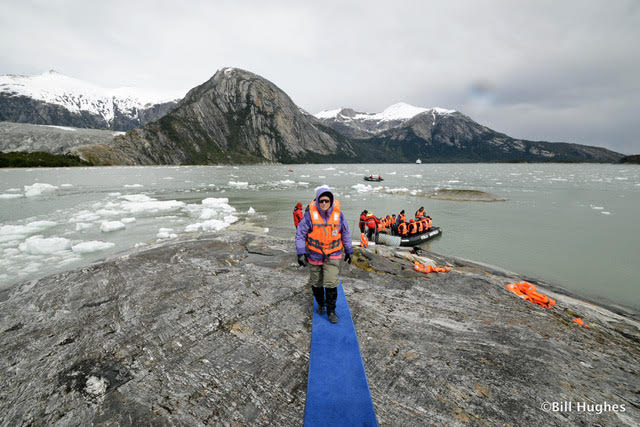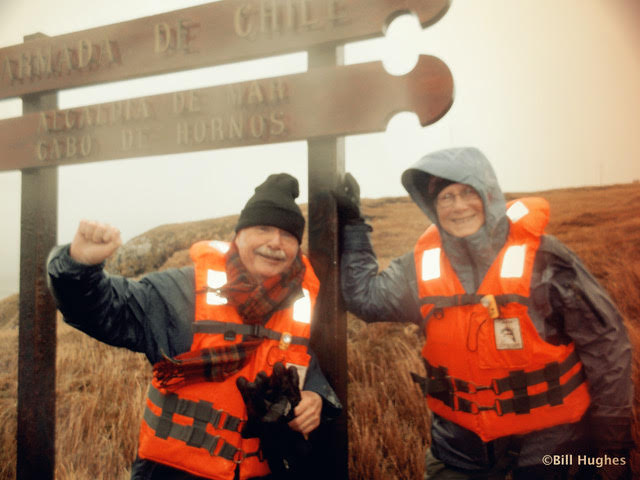Argentina, Chile & Cape Horn, the End of the World
At around age ten, my earliest memory of a personality from South America was not of any politician, artist, or explorer. It was of a legendary heavyweight boxer, Luis Angel Firpo – known as – “The Wild Bull of the Pampas!” (1)
His nickname captivated me! Firpo is buried in “La Recoleta Cemetery” in Buenos Aires, where I got a chance to pay my respects on November 24, 2013.

It was the beginning of my wife Ann’s and my memorable two week trip to Argentina, Chile and “Cape Horn” – the fabled end of the world. We finished our journey on December 7, 2013.
As the fates would have it, in that same Buenos Aires’ cemetery is buried Admiral William (Guillermo) Brown (1777-1857), a native of Ireland. He briefly lived in America as a young man, became a sea captain on merchant vessels and made his way to Argentina where he became a national hero. He is known as the “Father of the Argentinian Navy.”
Admiral Brown’s hometown in Ireland was Foxford, located in County Mayo. My mother, the late Nora Thornton, was born in the village of Tavanaghmore, only a few miles away.
There is a monument to Admiral Brown in Foxford, in the town’s square, which I saw on my first in visit to the west of Ireland in the early 1970s. I never dreamt that I would one day visit his grave in Argentina. Go figure.
As for Cape Horn, my wife Ann’s great-grandfather on her mother’s side, William Walton Freed, did travel around the feared promontory as a seaman on the British bark, “Iron Crag,” on November 15, 1878.
His account, “Before the Mast,” is reprinted in the family’s history book. It reveals a harrowing experience. So, a visit to celebrated Cape Horn, has been on Ann’s agenda for a good while.
Although we had been to many countries in Central America over the years, and also to Venezuela and Peru, this was our first trip to the far end of South America. Chile and Argentina share a common border that runs roughly for 3,300 miles along the majestic, snow-covered Andes Mountains.
Back then, one of the popular tourist attractions in Argentina was Archbishop’s Jorge Bergoglio’s cathedral/parish in Buenos Aires, but the good cleric was no longer there! He was now – Pope Francis!
Archbishop Bergoglio was elevated to the pontificate on March 13, 2013. We did get a chance to check out the “Metropolitan Cathedral,” where he had once served. I found out that he was very popular in both Argentina and Chile.
One woman told me: “Pope Francis is a breath of fresh air. I’m thinking seriously,” as she laughed out loud, “of coming ‘back’ to the church!” I responded, in chorus,“Me too!”
Over all, we spent four days in Buenos Aires and environs. Imagine traffic like in the flick, “Rush Hour!” That’s Buenos Aires!
The Plaza de Mayo, in Buenos Aires, was our next stop. Sadly, there have been some evil-doings associated with it. From 1976 to 1983, Argentina was engaged in a “Dirty War,” a time of blood-filled “state terrorism.”
There may have been as many as 30,000 innocent victims. To learn more about this grim subject, and about the participation in the mass protest actions over the missing and the dead, led by the brave mothers of that city, check out: “Madras de Plaza de Mayo.” (2)
I also recommend, on a much lighter note, a visit to Buenos Aires’ artsy, working-class neighborhood, the charming – “La Boca” – located in the old waterfront district.
Leaving Buenos Aires, we took a plane ride to a boomtown, Calafate, found on the great windswept plains of the Patagonian steppes. Think film director John Ford and his fave cowboy, “Big” John Wayne.
The flight took five hours. As we inched closer to Chile, we visited by bus some of “Los Glaciares National Park.” Is it big? Try 1,700 square miles! The highlight for us was a close-up view of the Perito Moreno Glacier.
Along the way, we crossed the border with Chile and headed towards Punta Arenas, a bustling port city. Passing through the Torres del Paine, we saw a spectacular waterfall. There were also a wide variety of bird species, guanacos, Andean condors and gray foxes to admire. We even worked in a visit to a delightful sheep farm.

The WaterfallFrom Punta Arenas, we boarded our expeditionary vessel, the Chilean “Stella Australis.” The accommodations and the food were first-class.
This was our home for the next four days and nights as we sailed the pristine waters of the Strait of Magellan, Beagle Channel, Ainsworth Bay, Glacier Alley, Wulia Bay and eventually around Cape Horn, where the mighty Atlantic and Pacific Oceans meet.
I did encounter one Chilean, in Punta Arenas who was willing to speak off the record, about the ex-dictator General Augusto Pinochet’s lethal 17-year legacy in his country (1973-90). He told me: “At the end of the day, Democracy prevailed. But, it was a very heavy price to pay. We’re glad to now say: Pinochet is gone! And yet we know the Far Right is till very strong in our country and it can come back with a murderous fury.”
As an American, I was embarrassed to note the late President Richard M. Nixon and his Iago-like hatchet man, Henry Kissinger’s, reputed roles as accomplices in that awful reign of terror. (3)
Getting back to the tour. Our delightful cruise continued on Dec. 1, 2013, into Ainsworth Bay, where our vessel moored close to the 120-foot-high Marinelli Glacier.
Later, our expedition ship sailed to Tucker Islet, where we made an excursion near the shore, via our zodiac life raft boats, to catch sight of the famed Magellanic penguins. The skua galls and the cormorant birds like to hang out here, too, along with other Fuegian birds.
I could have sworn I saw one of my fave actors, Danny “The Penguin” DeVito, hopping around on that island, while squawking his little head off. Check out his “Penguin” role in the popular flick, “Batman Returns” (1992).
We had a lovely excursion, too, one day to “Glacier Alley,” where sits fabled “Pia Glacier.” Again, we used the ship’s zodiac life rafts boats to transport us to the shoreline. As a passenger on it, I felt like I was a member of a U.S. Navy Seal team. Once there, we checked out the glacier from its origins in the Darwin Mountain Range, to where it meets the sea.

By way of a cautionary environmental note, a study in 2003, by researchers from the U.S. Jet Propulsion Laboratory, has documented the fact that the Pantagonian ice fields of both Chile and Argentina, due to the effects of global warming, are “the fastest area of glacial retreat on Earth!”
I’d be remiss if I didn’t say a word about the tour’s sponsor, “Overseas Adventure Travel;” our tour leader, Ms. Gracieala Rubin; and the captain and the crew of the vessel, “Stella Australis.” Well, here is that word: “Bravissimo!”
As for the people of Argentina and Chile, they couldn’t have been nicer to us. It’s true that their lands, lakes and rivers are very beautiful. And, so is something else that goes mostly unsung – the beauty of their women!
All of the above brings us to the apex of our journey – Cape Horn. On December 3, 2013, we reached it – “the continent’s southernmost point.” At times on our climb up the promontory, the wind speed hit around 60 mph. The rain felt, often, like it was cutting my face. While moving towards the “Albatross” monument, we were able to take refuge in a chapel and also a lighthouse, which is maintained by the Chilean Navy.

Finally, magnificent Cape Horn, steeped in global maritime history, deserves a poem. Therefore, in closing, I offer one from a Chilean poet, Ms. Sara Vial. It is entitled: “Cape Horn Memorial.”
“I am the albatross that awaits you
At the end of the world.
I am the forgotten souls of dead mariners
Who passed Cape Horn
From all the oceans of the world.
But they did not die
In the furious waves.
Today they sail on my wings
Toward eternity,
In the last crack
Of the Antarctic winds.”
- https://www.britannica.com/
biography/Luis-Angel-Firpo - https://www.history.com/news/
mothers-plaza-de-mayo- disappeared-children-dirty- war-argentina. - https://nsarchive2.gwu.edu/
NSAEBB/NSAEBB437/.
To see more photos from this tour, check out my Facebook page.

Bill Hughes is an attorney, author, actor and photographer. His latest book is “Byline Baltimore.” It can be found at: https://www.amazon.com/William-Hughes/e/B00N7MGPXO/ref=dp_byline_cont_book_1

